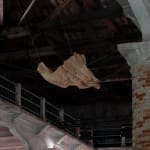Rindon Johnson
For example, collect the water just to see it pool there above your head. Don’t be a Fucking Hero!, 2021
Rawhide, dirt, water, paracord
Dimensions variable
Copyright The Artist
Photo: Ugo Carmeni
Weitere Abbildungen
Rindon Johnson ist von Adriano Pedrosa eingeladen worden sein Werk „For example, collect the water just to see it pool there above your head. Don’t be a Fucking Hero!“ (2021-ongoing),...
Rindon Johnson ist von Adriano Pedrosa eingeladen worden sein Werk „For example, collect the water just to see it pool there above your head. Don’t be a Fucking Hero!“ (2021-ongoing), von der Decke hängend im Arsenale der 60. Venedig Biennale als Teil der Hauptausstellung zu präsentieren. In dieser fortlaufenden Serie setzt sich Johnson mit Leder als Nebenprodukt und Relikt kolonialer und industrieller Verarbeitungsketten auseinander, um die miteinander verwobene systematische Problematik der Konstruktion von Rasse, Tierrechten und der vom Menschen verursachten Klimakrise zu benennen. Als Nebenprodukt der Fleischindustrie erworben, behandelt der Künstler die hängenden Häute mit verschiedenen Mitteln, wie Polyurethan, Bleichmittel, Mineralen und Farbstiften und überlässt sie für Monate der Witterung, die ebenfalls Spuren in das Leder zeichnet. Johnson nimmt sich der tierischen Ressource an und verweist durch deren Präsentation auf die allgemeine Unterwerfung, Vernachlässigung und Austauschbarkeit von Nutztieren in unserer heutigen Zeit. Der eigentliche Akt der Häutung, eine gewaltsame Überschreitung der Körpergrenzen, veranschaulicht diese Form der Objektivierung. Johnson wirft mit seinen Arbeiten aus Leder auch Fragen hinsichtlich Autonomie und Macht auf, indem er den Umgang mit Tieren auf gesellschaftliche Diskriminierungsmuster und deren komplexe Strukturen überträgt. So spiegeln die Häute Aspekte identitätspolitischer und klassistischer Themen, sowie Praktiken der rassistischen Ausbeutung wider.
Rindon Johnson is invited by Adriano Pedrosa to position the work For example, collect the water just to see it pool there above your head. Don’t be a Fucking Hero!“ (2021-ongoing), suspended from the ceiling in the 60th Venice Biennale’s Arsenale as part of the main exhibition. Johnson’s ongoing rawhide based works name leather as a by-product and relic of industrial processing chains in order to name the intertwined systematic problematics of the construction of race, animal rights and the human constructed climate crisis. Acquired as a by-product of the meat industry, the artist treats the hanging hides with various agents such as polyurethane, bleach, minerals and colored pencils and exposes it to the weather for months which also draws traces on the skin. Johnson takes on the animal resource and, through its presentation, refers to the general subjugation, neglect and interchangeability of farm animals in our time. The actual act of skinning, a violent transgression of bodily boundaries, illustrates this form of objectification. Johnson raises questions in the work series, in which he addresses the subjugation, neglect and exchangeability of non-human actors in our contemporary times, while drawing parallels to identity politics and classist themes, as well as practices of racist exploitation.
Rindon Johnson is invited by Adriano Pedrosa to position the work For example, collect the water just to see it pool there above your head. Don’t be a Fucking Hero!“ (2021-ongoing), suspended from the ceiling in the 60th Venice Biennale’s Arsenale as part of the main exhibition. Johnson’s ongoing rawhide based works name leather as a by-product and relic of industrial processing chains in order to name the intertwined systematic problematics of the construction of race, animal rights and the human constructed climate crisis. Acquired as a by-product of the meat industry, the artist treats the hanging hides with various agents such as polyurethane, bleach, minerals and colored pencils and exposes it to the weather for months which also draws traces on the skin. Johnson takes on the animal resource and, through its presentation, refers to the general subjugation, neglect and interchangeability of farm animals in our time. The actual act of skinning, a violent transgression of bodily boundaries, illustrates this form of objectification. Johnson raises questions in the work series, in which he addresses the subjugation, neglect and exchangeability of non-human actors in our contemporary times, while drawing parallels to identity politics and classist themes, as well as practices of racist exploitation.









